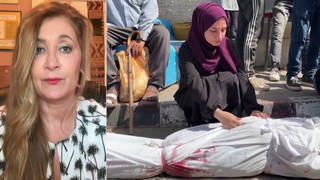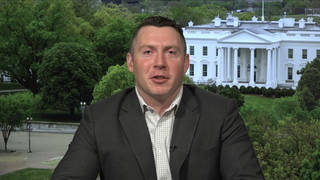This content originally appeared on Democracy Now! and was authored by Democracy Now!.
This post was originally published on Radio Free.
This content originally appeared on Democracy Now! and was authored by Democracy Now!.
This post was originally published on Radio Free.
This content originally appeared on The Intercept and was authored by The Intercept.
This post was originally published on Radio Free.
This content originally appeared on Democracy Now! and was authored by Democracy Now!.
This post was originally published on Radio Free.
This content originally appeared on Democracy Now! and was authored by Democracy Now!.
This post was originally published on Radio Free.
A video journalist for Fox News said he was hit with an umbrella by a congressional staff member during an interview with Rep. Rashida Tlaib on the U.S. Capitol grounds on May 23, 2024.
The videographer was attempting to record Tlaib, D-Mich., as senior congressional correspondent Chad Pergram asked for her reaction to Israeli Prime Minister Benjamin Netanyahu being invited to address Congress.
In a video clip of the incident posted on social network X, the staffer can be seen first unfurling the umbrella to deter Pergram. Then, after closing the umbrella, he opened it again to obscure the cameraman’s view of Tlaib as she spoke. The camera visibly wobbles and the cameraman’s voice is heard saying, “He hit me with an umbrella.”
The aide denies striking him on camera.
Pergram responds, “We have it on video, guys.
“He hit him with the umbrella,” Pergram says as he walks past a Capitol police officer. “That’s assault.”
Neither the staff member nor the cameraman were identified. Tlaib’s director of communications didn’t respond to an email request from the U.S. Press Freedom Tracker seeking comment.
Fox News communications executive Caley Cronin confirmed the incident via email with the Tracker and pointed to a Fox News report for details.
This content originally appeared on U.S. Press Freedom Tracker: Incident Database and was authored by U.S. Press Freedom Tracker: Incident Database.
This post was originally published on Radio Free.
This content originally appeared on Democracy Now! and was authored by Democracy Now!.
This post was originally published on Radio Free.
This content originally appeared on Radio Free Asia and was authored by Radio Free Asia.
This post was originally published on Radio Free.
This content originally appeared on Democracy Now! and was authored by Democracy Now!.
This post was originally published on Radio Free.
This content originally appeared on Democracy Now! and was authored by Democracy Now!.
This post was originally published on Radio Free.
This content originally appeared on Democracy Now! and was authored by Democracy Now!.
This post was originally published on Radio Free.

A pair of new United Nations reports has accused Israel, as well as Hamas, of committing war crimes in Gaza. The damning documents come as Israel and Hamas are being urged to accept the three-phase ceasefire and hostage deal outlined by President Biden and endorsed by the U.N. Security Council. “Israel has no interest in international law, and the United States has no interest in demanding that Israel actually comply with international law besides rhetorical flourishes,” says Sarah Leah Whitson, executive director of DAWN. “It will come to haunt and hurt America for decades to come.”
This content originally appeared on Democracy Now! and was authored by Democracy Now!.
This post was originally published on Radio Free.
This content originally appeared on Radio Free Asia and was authored by Radio Free Asia.
This post was originally published on Radio Free.
This content originally appeared on Radio Free Asia and was authored by Radio Free Asia.
This post was originally published on Radio Free.
This content originally appeared on Democracy Now! and was authored by Democracy Now!.
This post was originally published on Radio Free.
This content originally appeared on Democracy Now! and was authored by Democracy Now!.
This post was originally published on Radio Free.

We speak with U.S. Army Major Harrison Mann, the first military and intelligence officer to publicly resign over the Biden administration’s support for Israel’s war on Gaza. Mann left his role at the Defense Intelligence Agency after a 13-year career, saying in a public letter explaining his resignation that “nearly unqualified support for the government of Israel … has enabled and empowered the killing and starvation of tens of thousands of innocent Palestinians.” Mann submitted his resignation on November 1, just over three weeks into Israel’s assault on Gaza, but his separation from the military became effective last week. “Even in the first weeks after October 7 … it was really clear that they were prepared to inflict huge numbers of civilian casualties,” Mann tells Democracy Now! “I understood that every day that I was going to go into the office, I was going to be contributing to the Israeli campaign.” Mann also explains how his Jewish background impacted his decision to resign, saying that while he was proud to wear the same uniform of soldiers who liberated Nazi concentration camps during World War II, it was “impossible” not to see echoes of the Holocaust in the devastation of Gaza. “Seeing photos of charred bodies and burnt corpses and starved, emaciated children that are from 2023, 2024, not the '40s, it's impossible not to make that connection,” says Mann. “The situations are not perfectly analogous, but the moral similarities were very clear to me.”
This content originally appeared on Democracy Now! and was authored by Democracy Now!.
This post was originally published on Radio Free.
This content originally appeared on Democracy Now! and was authored by Democracy Now!.
This post was originally published on Radio Free.
This content originally appeared on Democracy Now! and was authored by Democracy Now!.
This post was originally published on Radio Free.
This content originally appeared on Democracy Now! and was authored by Democracy Now!.
This post was originally published on Radio Free.
This content originally appeared on Democracy Now! and was authored by Democracy Now!.
This post was originally published on Radio Free.
This content originally appeared on ProPublica and was authored by ProPublica.
This post was originally published on Radio Free.
This content originally appeared on ProPublica and was authored by ProPublica.
This post was originally published on Radio Free.
This content originally appeared on Democracy Now! and was authored by Democracy Now!.
This post was originally published on Radio Free.
This content originally appeared on Democracy Now! and was authored by Democracy Now!.
This post was originally published on Radio Free.
This content originally appeared on Democracy Now! and was authored by Democracy Now!.
This post was originally published on Radio Free.
This content originally appeared on Democracy Now! and was authored by Democracy Now!.
This post was originally published on Radio Free.

Guilty on all 34 felony counts — that’s the historic verdict delivered Thursday by a New York jury in former President Donald Trump’s hush money and election fraud criminal trial. Trump was charged with falsifying business records to cover up payments made to adult film star Stormy Daniels in order to protect his 2016 presidential campaign and is now the first former president to be convicted of a felony, facing the possibility of up to four years in prison. Judge Juan Merchan set his sentencing date on July 11, four days before the Republican National Convention, where Trump will become the party’s official presidential nominee. Trump, who can still be president as a convicted felon, slammed the verdict as a “disgrace,” and his defense team plans to appeal. We speak with criminal defense attorney Ron Kuby, who followed the case closely and says there was a “tsunami of circumstantial evidence” that supported the prosecution’s case. “The defense never posed any sort of realistic counternarrative,” says Kuby.
This content originally appeared on Democracy Now! and was authored by Democracy Now!.
This post was originally published on Radio Free.
The Committee to Protect Journalists joined more than 85 journalism and civil society organizations and 35 attorneys and law professors in urging the Senate Judiciary Committee to schedule a markup of the Protect Reporters from Exploitative State Spying Act (PRESS Act) as soon as possible so that it can be considered by the full Senate and become law.
The PRESS Act would create a federal shield law, protecting journalist-source confidentiality and preventing government surveillance of journalistic activity through phone and email providers.
The legislation, which CPJ helped author, passed the House twice but has previously languished in the Senate.
Read the full letter:
This content originally appeared on Committee to Protect Journalists and was authored by Committee to Protect Journalists.
This post was originally published on Radio Free.
This content originally appeared on Democracy Now! and was authored by Democracy Now!.
This post was originally published on Radio Free.
This content originally appeared on Democracy Now! and was authored by Democracy Now!.
This post was originally published on Radio Free.